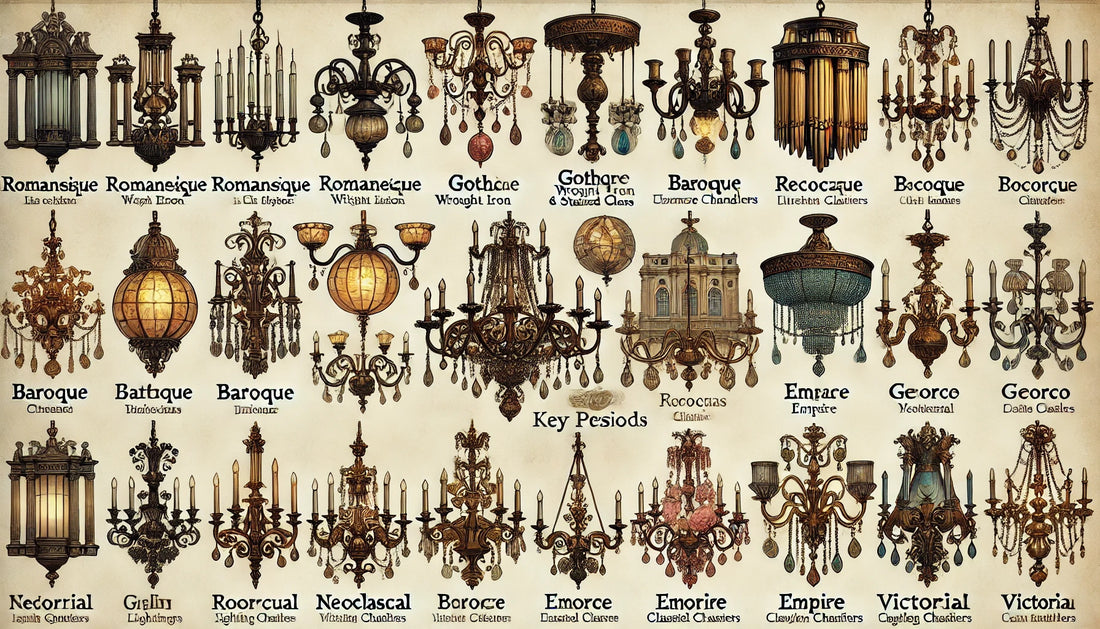
Exploring the Evolution of European Lighting Styles – From Medieval to the Victorian Era
Lejeune HuThe history of European lighting design is rich and varied, mirroring the artistic, cultural, and architectural movements that shaped the continent over centuries. From the stark simplicity of the Romanesque era to the elaborate detailing of the Victorian period, lighting fixtures have evolved dramatically in style, materials, and function. This blog will explore key lighting styles across different European eras, capturing their unique characteristics.
See What We Have > > > Lighting Collection

Romanesque Lighting (10th-12th Century)
In the Romanesque period, lighting was designed with practicality in mind, reflecting the sturdy, fortress-like architecture of the time. Fixtures were typically made from iron, featuring simple, functional forms like candle chandeliers. These pieces were essential for lighting large, dimly lit spaces such as churches and castles, offering minimal decorative elements.

Gothic Lighting (12th-16th Century)
The Gothic period saw a transformation in both architecture and lighting design. Chandeliers became taller, with more ornate designs that emphasized verticality, mimicking the soaring ceilings and pointed arches of Gothic cathedrals. Wrought iron chandeliers featured intricate tracery and complemented the grandeur of stained glass windows, which added vibrant, colorful lighting to the interiors.

Renaissance Lighting (14th-17th Century)
The Renaissance marked a return to classical ideals of symmetry, proportion, and balance. Lighting fixtures became more sophisticated, often featuring bronze or brass materials with finely detailed carvings. Chandeliers and sconces from this period were elegant and symmetrical, with motifs drawn from classical antiquity, such as laurel wreaths and mythological figures. These fixtures were designed to illuminate the grand halls of palaces and civic buildings.

Baroque Lighting (17th Century)
Baroque lighting took grandeur to new heights, reflecting the extravagance and drama of Baroque art and architecture. Chandeliers were made of bronze or gilded materials, adorned with crystals that reflected light in dazzling ways. Their elaborate designs included swirling curves, floral patterns, and intricate details, often creating a focal point in grand reception rooms and churches.

Rococo Lighting (Early 18th Century)
Rococo lighting embodied the playful and ornate spirit of the period. While retaining the elegance of Baroque, Rococo introduced lighter, more delicate designs. Chandeliers featured floral motifs, asymmetrical forms, and intricate scrollwork, with an emphasis on soft pastel colors and gold leaf finishes. These smaller, more intimate fixtures brought a sense of romance and whimsy to the interiors of French salons and private rooms.

Neoclassical Lighting (Late 18th Century)
As a response to the excesses of the Rococo period, Neoclassical lighting embraced a return to the simplicity and order of classical antiquity. Chandeliers and sconces from this era featured clean lines, geometric shapes, and classical motifs like urns and columns. Brass and bronze were common materials, with a focus on symmetry and elegance. This style brought a sense of calm and rationality, reflecting the ideals of the Enlightenment.

Georgian Lighting (18th Century, Britain)
The Georgian period in Britain saw lighting fixtures that mirrored the refined, symmetrical design principles of Neoclassicism. Brass chandeliers and sconces were simple yet elegant, with balanced proportions and subtle carvings. These fixtures complemented the stately homes of the era, adding a touch of sophistication without overwhelming the space.

Empire Lighting (Early 19th Century, France)
Empire lighting, emerging during the Napoleonic era, was grand and formal, influenced by military motifs and classical forms. Chandeliers were made of bronze or gilded metal, often featuring imperial symbols like eagles, wreaths, and laurel leaves. These designs were intended to evoke power and authority, befitting the palaces and formal spaces of Napoleon's empire.

Victorian Lighting (Mid-to-Late 19th Century, Britain)
The Victorian era was known for its eclecticism and decorative excess, and this was reflected in lighting design. Chandeliers and lamps from this period were highly ornate, often featuring brass, bronze, and glass elements. Floral motifs, intricate carvings, and colored glass were popular design features, with gas lighting technology becoming more common. Victorian lighting was heavy and decorative, a perfect match for the elaborate interiors of the time.

——————————————————————————————————————
Email - info@jewellerytop.com
Whatsapp - +8616620433352
Product Collection
Chandelier | Ceiling Lamp | Pendant Lamp | Wall Lamp | Table Lamp | Floor Lamp | Brass Downlight | Interior Decoration | Furniture | Mirror
Baroque & Rococo Design | Maria Theresa Design | High End Crystal Glass Design | Murano Glass Design | Country Design | Classical Design | Modern Luxury Design
